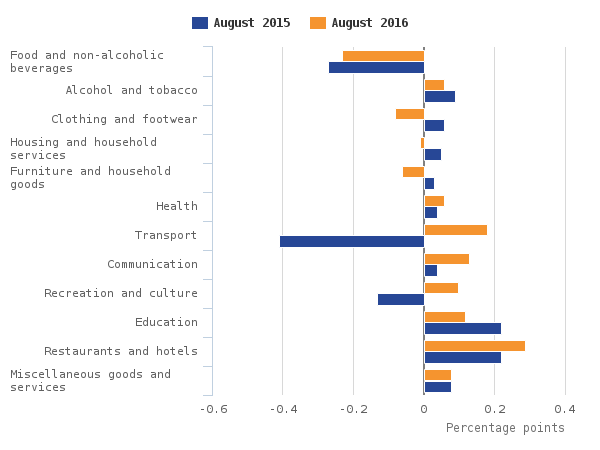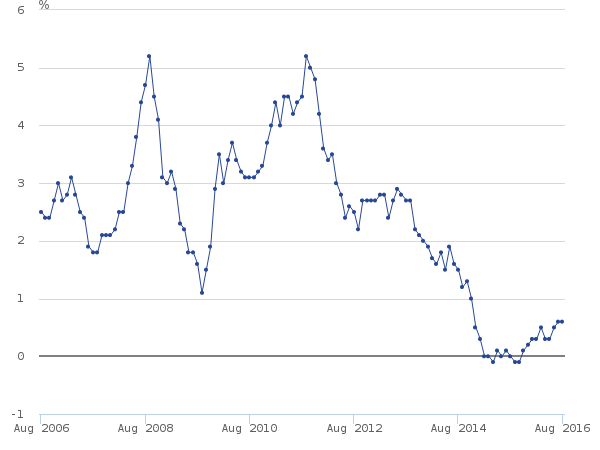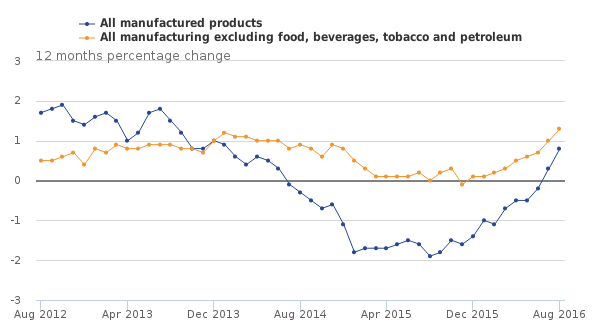Retail Economics Response - ONS Consumer Price Index August 2016
The Consumer Prices Index (CPI) remained at 0.6 per cent in August, unchanged on the previous month, after a 0.5 per cent rise in the previous month. The main upward contributors to change in the rate were rising food prices and air fares, and a smaller fall in the price of motor fuels than a year ago.These upward pressures were offset by falls in hotel accommodation prices, in addition to smaller rises in the prices of alcohol, and clothing and footwear than a year ago.
Chart 1 - Contributions to the change in the annual rate of CPI, August 2016
Source: ONSBetween July and August 2016, the main upward contributions to change in the CPI 12-month rate came from the following groups:Transport: inflation rose by 0.9 per cent between July and August this year, compared with a rise of 0.1 per cent between the same two months a year ago. Within transport, the largest upward effect came from motor fuels, with prices falling between July and August 2016 but by less than between the same two months last year. The effect came particularly from diesel with prices falling by 1.2 pence per litre this year compared with a fall of 6.2 pence per litre a year ago. Food and non-alcoholic beverages: the upward contribution came from food for which prices, overall, rose by 0.6 per cent between July and August this year compared with a fall of 0.2 per cent between the same two months a year ago. The main upward effects came from a range of bread and cereal products and meat products. The main downward contributions to change in the CPI 12-month rate between July and August 2016 came from the following groups:Restaurants and hotels: prices, overall, fell by 0.4 per cent, compared with a negligible change a year ago. The main downward contribution came from accommodation services, in particular overnight hotel accommodation, for which prices fell by more than a year ago.Clothing and footwear: prices, overall, rose by 1.0 per cent between July and August this year compared with a rise of 1.5 per cent between the same two months a year ago. The downward effect came principally from garments, particularly children’s outerwear.Alcoholic beverages and tobacco: within this category, the downward contribution came from alcoholic beverages, for which prices rose overall by 0.3 per cent between July and August 2016, compared with a larger rise of 2.4 per cent between the same two months last year. Furniture, household equipment and maintenance: the downward contribution came from furniture and furnishings with prices rising by less than a year ago across a range of furniture items.
Chart 2 - Consumer Price Index
Source: ONSThe Producer Price Index, indicative of costs faced by retailers from manufactures, rose 0.8 per cent in the year to August 2016, compared with a rise of 0.3 per cent in the year to July 2016. This is the second increase in a row following two years of falls.
Chart 3 - Producer Price Index – Output prices, percentage change year-on-year
Source: ONSThe impact of rising import costs is feeding through the supply chain and putting upward pressure on the cost of goods sold for UK retailers. While hedging and long-term contracts will slow the impact of rising costs over the coming months, with other costs also rising for retailers (e.g. National Living Wage), a high proportion will have to be passed on to consumers in the coming months. We expect consumer inflation to accelerate sharply from the beginning of 2017 through to the Spring.
Back to Retail Economic News